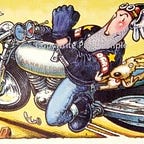The Virus, the Orphans and the Milkmaid's Bosom
It’s part of English folklore that milkmaids have plump, smooth, creamy bosoms. Curiously, the ongoing myth owes as much to a bunch of unfortunate Spanish orphans as to the emollient effect of cow’s milk.
This is why.
Since Egyptian times, tens of millions of people have been killed by smallpox. Spread by droplet infection, the highly contagious virus first gives its victims a fever, crippling muscular pain and headaches. Then it covers their bodies with suppurating boils before killing them stone dead within a couple of days.
The lucky few who survive are usually covered for life by hideously unattractive scarring and lumps, and often partially blinded too. The only upside is that once infected, survivors are highly unlikely to catch the disease a second time. Up until the mid 1700s, quack doctors treated new infections — and those who wanted to protect themselves from catching it — by blowing dried smallpox scabs up the noses of their patients; not a very pleasant procedure, even for the desperate.
But here’s the weird thing (and where those creamy bosoms come in): milkmaids from centuries back were reported to very rarely catch smallpox, so their bosoms (and faces and arms) remained delightfully unscarred and attractive. Hence that unblemished, peaches-and-cream skin reputation.
In 1796, an enquiring young English doctor called Edward Jenner heard the bosomy rumour, and asked about in his village in Gloucestershire as to why milkmaids might be resistant to the disfigurements of smallpox. His diligent inquiries revealed that most milkmaids caught a mild case of non-lethal cowpox in the course of their work tugging bovine teats, and subsequently developed small blisters on their hands.
Could it be, mused Jenner, that the cowpox blisters were linked to the apparent resistance to smallpox and its killer blisters? He decided to find out.
He experimented on a young peasant child (those were the days, eh? — no clinical trials or ethics problems then) by rubbing pus he squeezed from a milkmaid’s blister into a nick he’d made into the young peasant’s skin. The child was later exposed to smallpox, and, hey presto, survived with nary a symptom.
Jenner’s successful milkmaid-squeezing technique spread across Europe, and doctors soon began saving hundreds of lives. This was obviously among the ruling classes, because peasants (as we have already seen) were generally considered disposable.
Not all the posh folks survived however — King Charles IV of Spain watched in horror as his favourite young daughter, the Infanta Maria Teresa, caught smallpox and died. Worse still, one of his sailors who was tasked with sailing across the Atlantic to plunder the riches of the South American New World also caught smallpox. He survived, but took enough of his scabs onboard his ship to accidentally deliver them to what is now Mexico. There they enjoyed the climate, thrived, and killed some 24 million locals and expats by the start of the 1800s. Bummer indeed.
All this severely crimped Charles IV’s plans of enslaving the entire South American population and getting even richer than he already was, so he decided to send some cowpox pus overseas to infect his minions, so they could render themselves immune to smallpox, and thus happily carry on their royally-mandated plundering. But there was a problem.
Infect one person with cowpox and they become smallpox resistant — Jenner had proved that. But as infectees usually recovered in a week, the virus died with their healing blisters and no more pus was available. End of transmission chain unless you were a milkmaid.
The journey from Spain to Mexico took several months, so any active boils would be long gone by the time any infected carriers arrived — and refrigeration or hermetically sealed specimen jars weren’t yet invented. What to do? How to deliver live cowpox virus to the few stumbling smallpox survivors remaining over the ocean in Mexico? Poor Charles was flummoxed.
But the answer turned out to be amazingly simple: Just load up a Spanish galleon with a couple of dozen young (are we seeing a trend here?) peasant orphans, infect one with cowpox then just before he recovers, squeeze his blisters and scratch and infect another orphan as you sail on towards South America. Easy!
This innovative yet possibly slightly exploitative system worked flawlessly thanks to chief squeezer-and-scratcher Francisco Javier de Balmis, a surgeon from the King’s court.
Once settled into their quarters on the galleon, the María Pita, the orphans took their turn to become diseased as Francisco Javier expertly passed on their pus to the next young peasant in line; the virus lived on and active smallpox-preventing bugs arrived safely in the New World.
Once the María Pita docked, eager South American doctors scraped pus off orphan arms, Spanish nobles and courtiers were hastily inoculated, and the scourge of smallpox was defeated in the Americas (the Spanish bit, anyway) by the first ever mass vaccination programme in the world, hurrah.
History doesn’t record the names of the 22 boy orphans who saved the lives of millions and helped enrich the Spanish empire for many more decades, but at least their pustules gained immortality.
Because the lifesaving pus came from the cowpox infection, it was decided to call the act of squeezing and infecting ‘vaccination’, from the Latin vacca which means cow. Personally, I think it would be fairer to call it rusticonation, from the Latin for peasant. But then again, by contemporary standards those peasants weren’t as important as the cows, were they?
For more of my stories, click HERE.
